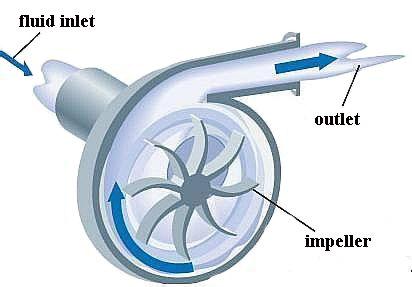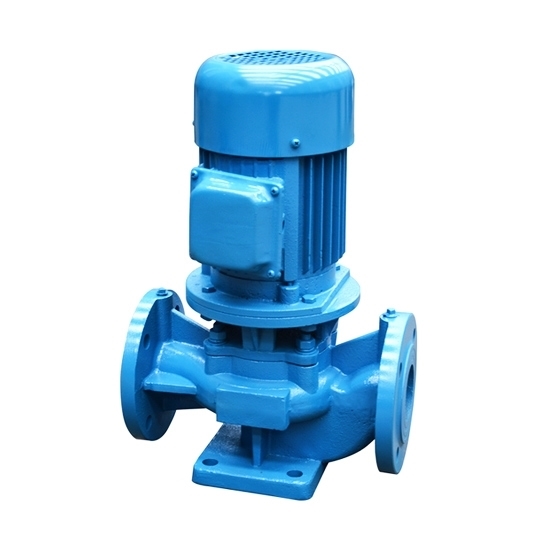Centrifugal Pump: Working Principle, Advantages, Maintenance and Application
A centrifugal pump is a mechanical device designed to move a fluid by means of the transfer of rotational energy from one or more driven rotors, called impellers. Fluid enters the rapidly rotating impeller along its axis and is cast out by centrifugal force along its circumference through the impeller's vane tips.
Working Principle of Centrifugal Pump
When the impeller of centrifugal pump rotates rapidly, the liquid in the impeller also rotates under the push of the blades in the impeller, so that the liquid obtains centrifugal force and moves outward from the center of the impeller along the flow passage of the blade, and then is thrown from the end of the blade. Out into the volute chamber or diffuser tube (or guide wheel) inside the pump casing. When the liquid flows to the diffuser, the cross-sectional area of the liquid gradually expands and the flow rate slows down. A part of the kinetic energy is converted into a static energy head, so that the pressure rises, and finally it is pressed out from the discharge pipe. At the same time, a partial vacuum is generated in the center of the impeller because the liquid is thrown out, so the liquid in the suction pool is continuously sucked into the pump from the suction pipe under the action of the liquid surface pressure. The impeller rotates continuously, and the liquid is continuously sent from the suction tank to the high-level tank or pressure vessel.

Advantages of Centrifugal Pump
- The structure of the single stage centrifugal pump is simple. For the same unit of conveying volume, the centrifugal pump occupies a smaller area, has lower material loss, and has low basic requirements, which can save installation costs.
- The centrifugal pump can be directly connected with a 2-pole or 4-pole motor to achieve high-speed operation, and the rotating structure is simple and easy to install.
- There is no valve in the centrifugal pump, so it is more suitable for conveying suspension. With a special design, suspensions of bulk solids can also be transported by centrifugal pumps.
- The centrifugal pump is resistant to chemical corrosion, so it can transport dangerous corrosive solutions.
- Because the centrifugal pump has a simple structure, fewer parts, fewer failures, and is durable, the maintenance cost is lower than other types of products.
- The delivery volume can be adjusted arbitrarily according to the discharge valve, and there will be no danger of infinite rise of the pressure head. If the amount of liquid to be transported is large and the pressure head is not required to be large, the centrifugal pump is very suitable.

- There will be no pulse phenomenon during discharge.
Maintenance of Centrifugal Pump
- After the preparation is ready, start the centrifugal pump. When starting, pay attention to the rotation direction and current changes. In the case of ensuring that the seal is not leaking, wait until the current, revolutions and pressure all reach the normal indicators, and then slowly open the outlet valve.
- Be careful not to let the pump run for a long time with the outlet valve closed, not more than three minutes. Otherwise, air bubbles created by the elevated temperature of the liquid circulating in the pump may cause the pump to evacuate.
- The flow rate of the centrifugal pump cannot be adjusted by the inlet valve, but must be controlled by the outlet valve.
- When the centrifugal pump is in normal operation, check the outlet pressure and current of the pump at all times to ensure that it does not exceed the rated index.
- Check whether there is noise or vibration when the centrifugal pump is running. If so, find out the cause and deal with it in time. Don't forget to regularly higher oil and grease.
- Ensure that the bearing temperature is less than or equal to 65 degrees Celsius, and the motor temperature is less than or equal to 70 degrees Celsius.
Application of Centrifugal Pump
The fact that centrifugal pumps are the most popular choice for fluid motion makes them a strong contender for many applications, and as mentioned, they are used in numerous industries. Water supply, pressurization, pumping domestic water, auxiliary fire protection systems, hot water circulation, sewage discharge and conditioning boiler water are the most common applications. Some of the main sectors that use these pumps are outlined below:
- Oil and energy - pumping crude oil, slurries, slurries; used in refineries, power plants.
- Industrial and Fire Protection – Heating and ventilation, boiler feed water applications, air conditioning, pressurization, fire sprinkler systems.
- Waste Management, Agriculture and Manufacturing - Wastewater treatment plants, municipal industry, drainage, gas treatment, irrigation and flood control.
- Pharmaceutical, chemical and food industries - Paints, hydrocarbons, petrochemicals, cellulose, sugar refining, food and beverage production.
- Various industries (manufacturing, industrial, chemical, pharmaceutical, food production, aerospace, etc.) - For cryogenics and refrigerants.

